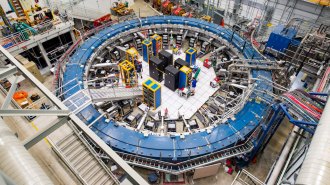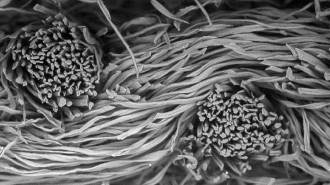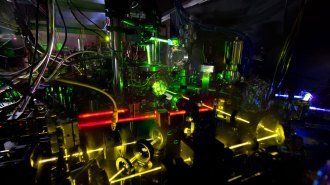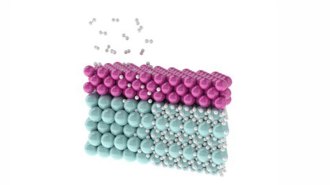Physics
Sign up for our newsletter
We summarize the week's scientific breakthroughs every Thursday.
-
 Particle Physics
Particle PhysicsHow matter’s hidden complexity unleashed the power of nuclear physics
In the last century, physicists learned to split atomic nuclei and revealed a complex world of fundamental particles.
-
 Particle Physics
Particle PhysicsMuon magnetism could hint at a breakdown of physics’ standard model
After two decades, a new measurement of the muon magnetic anomaly reinforces earlier hints that its value disagrees with standard physics.
-
 Physics
PhysicsNewly made laser-cooled antimatter could test foundations of modern physics
Physicists have finally used laser cooling to tame unruly antimatter atoms. That could allow new tests of symmetry and Einstein’s theory of gravity.
-
 Materials Science
Materials ScienceMicroscopic images reveal the science and beauty of face masks
Important insights into the particle-filtering properties of different fabrics also offer a sense of the unseen, textured world of face masks.
-
 Physics
PhysicsUranium ‘snowflakes’ could set off thermonuclear explosions of dead stars
Uranium crystals that settle in the cores of white dwarfs could trigger nuclear chain reactions that blow the dead stars apart, a new study suggests.
-
 Physics
PhysicsAtomic clocks take a step toward redefining the second
Measurements of the clocks’ frequencies provide the most precise clock comparisons yet, with uncertainties less than a quadrillionth of a percent.
-
 Physics
PhysicsCan room-temperature superconductors work without extreme pressure?
The next generation of materials that conduct electricity with no resistance could shrug off the need for high pressure and low temperatures.
-
 Physics
PhysicsA tiny gold ball is the smallest object to have its gravity measured
A gold sphere with a mass of about 90 milligrams pulled on another sphere in accordance with Newton’s law of universal gravitation.
-
 Physics
PhysicsA magnetic trap captures elusive ultracold plasma
Pinning plasma within a set of magnetic fields offers physicists a new way to study clean energy, space weather and the inner workings of stars.
-
 Materials Science
Materials ScienceThis soft robot withstands crushing pressures at the ocean’s greatest depths
An autonomous robot that mimics the adaptations of deep-sea snailfish to extreme conditions was successfully tested at the bottom of the ocean.
-
 Physics
PhysicsBlack hole visionaries push the boundaries of knowledge in a new film
‘Black Holes: The Edge of All We Know’ follows researchers with the Event Horizon Telescope and other physicists working to understand black holes.
-
 Tech
TechA new laser-based random number generator is the fastest of its kind
A new laser’s chaotic light beam lets the device generate multiple number sequences at once, similar to throwing multiple dice at a time.